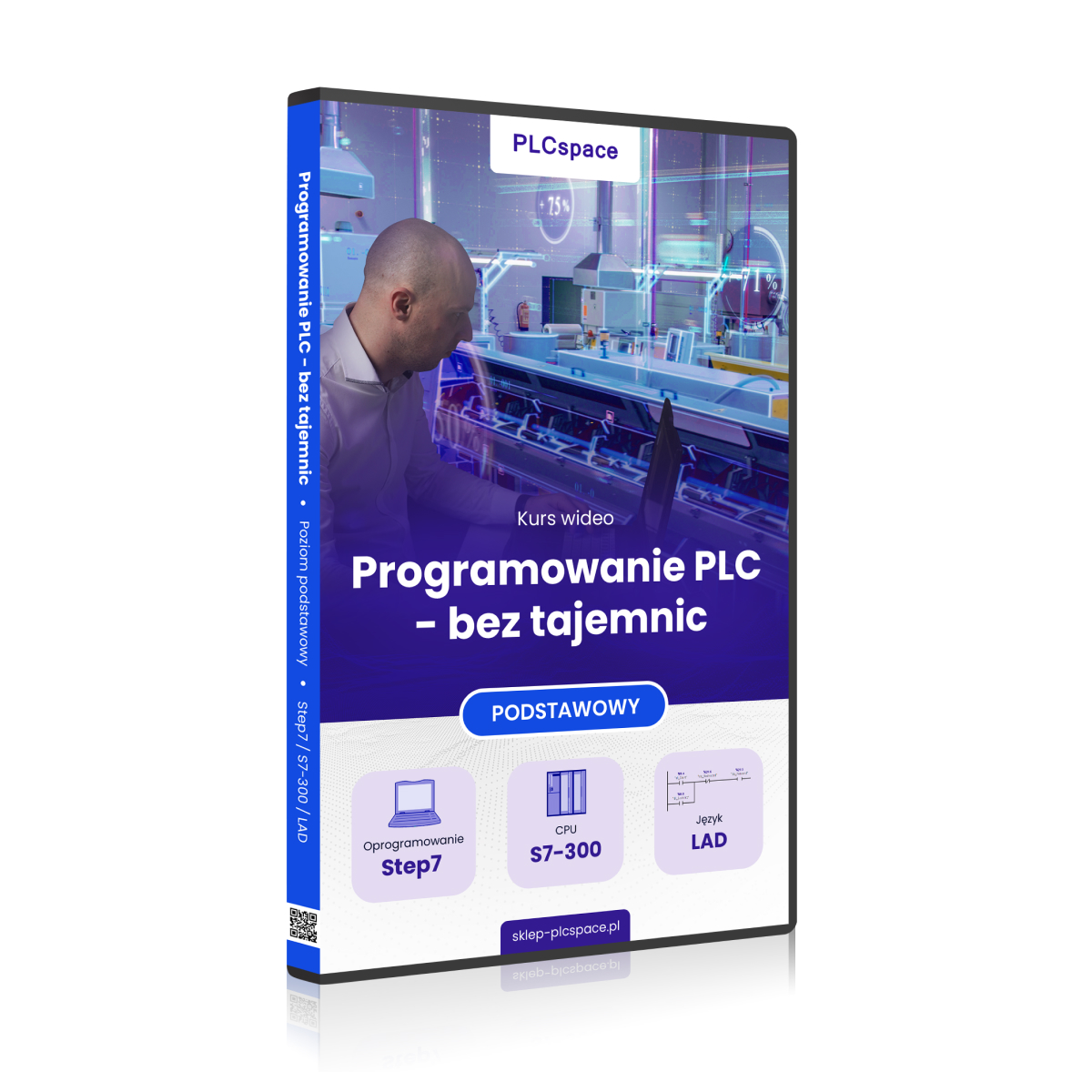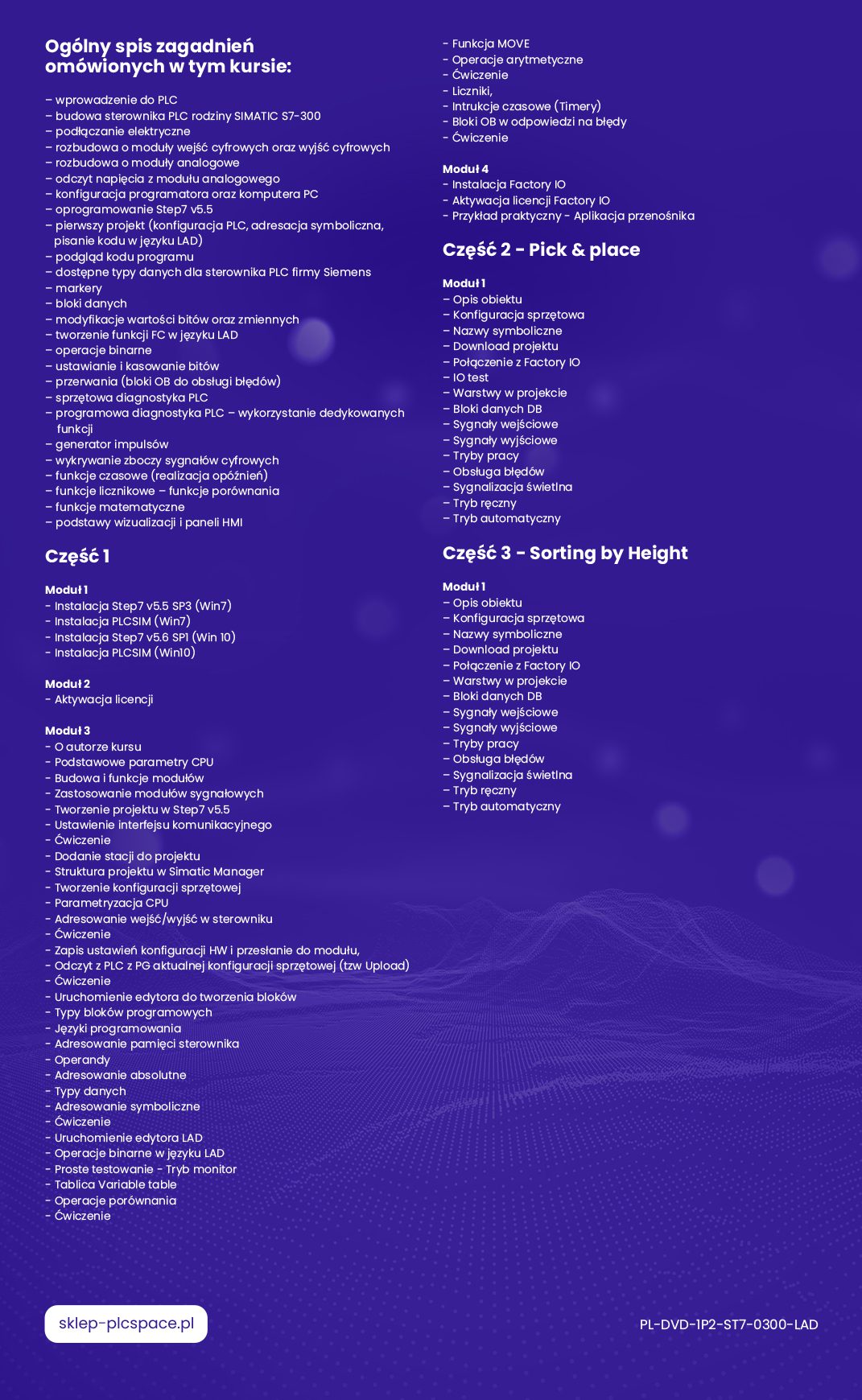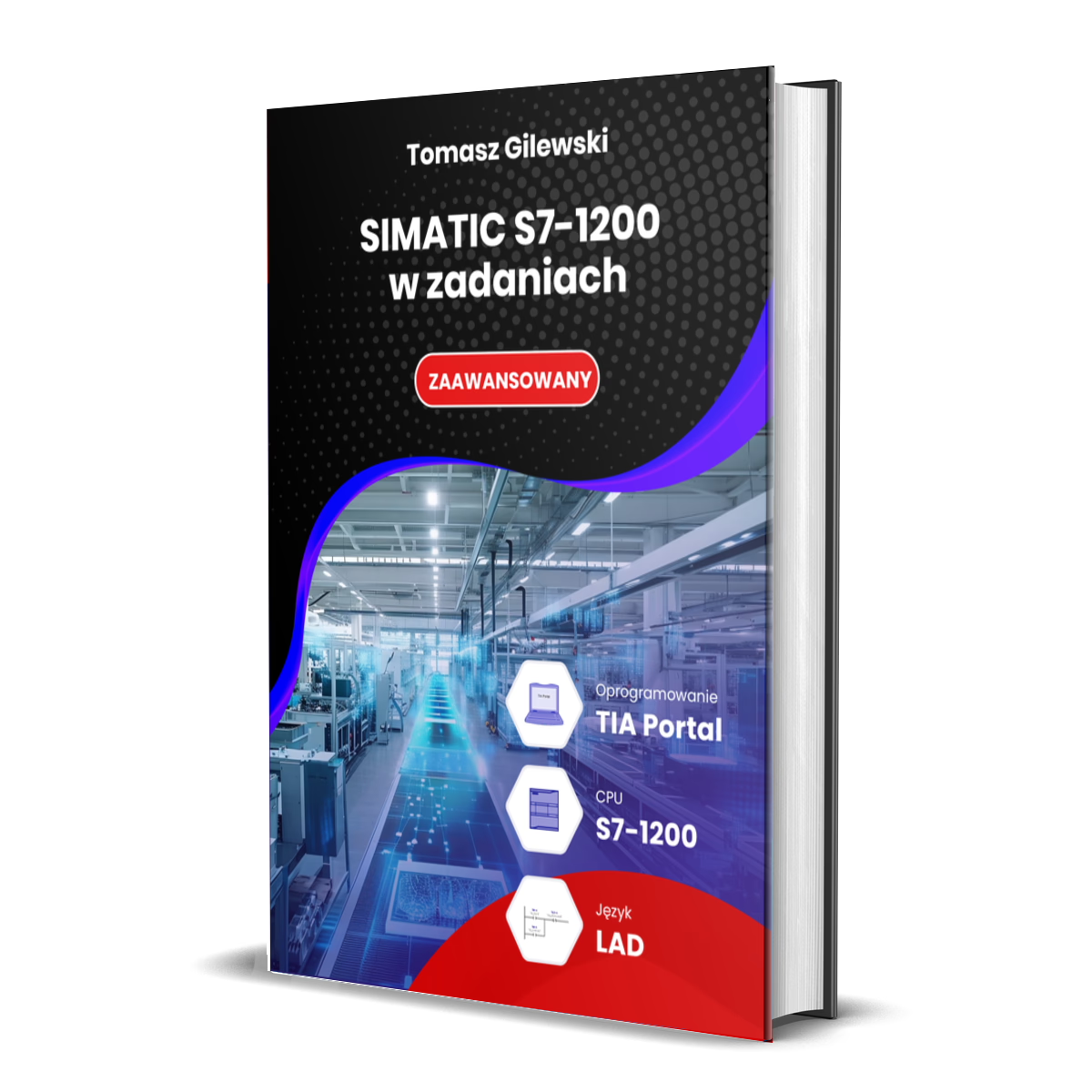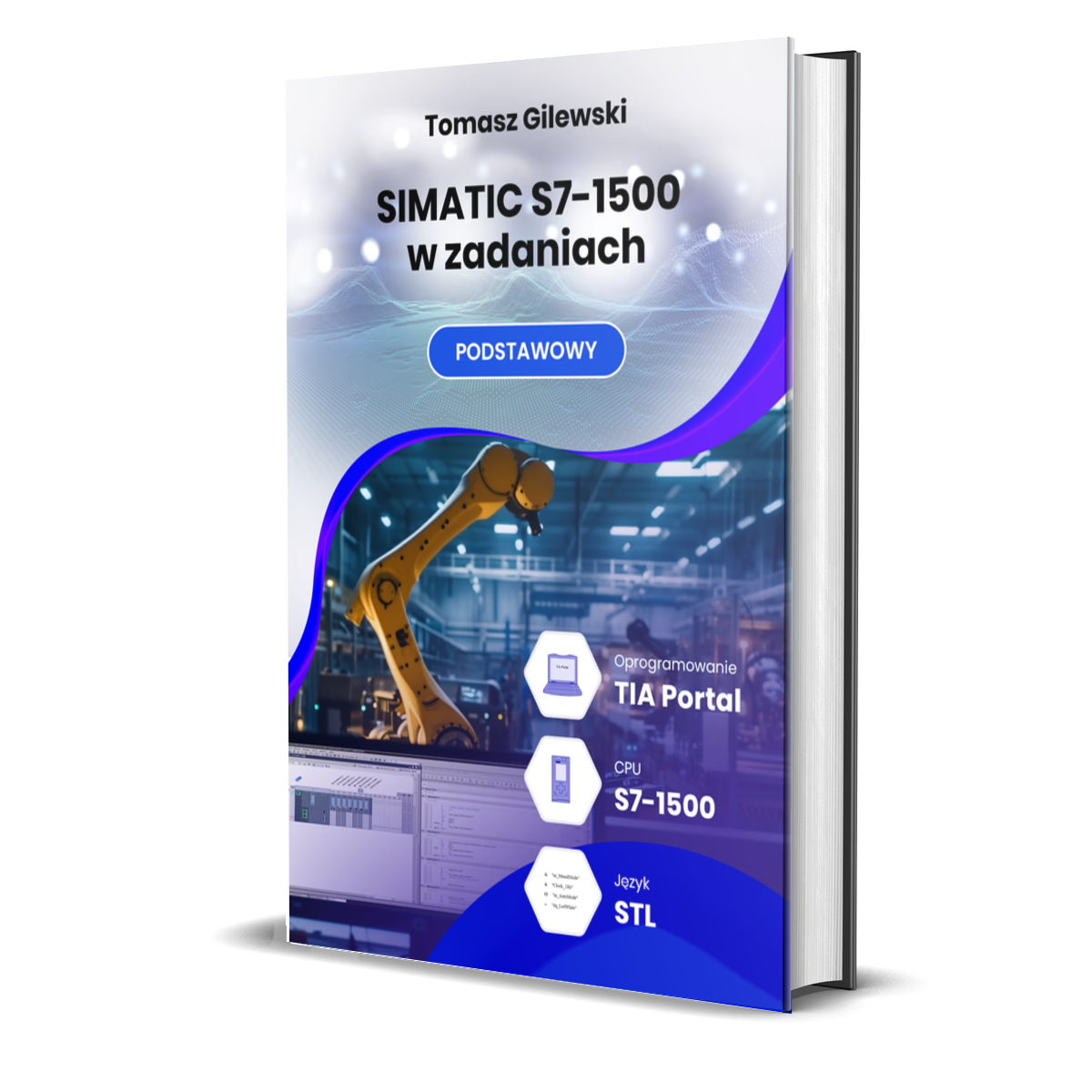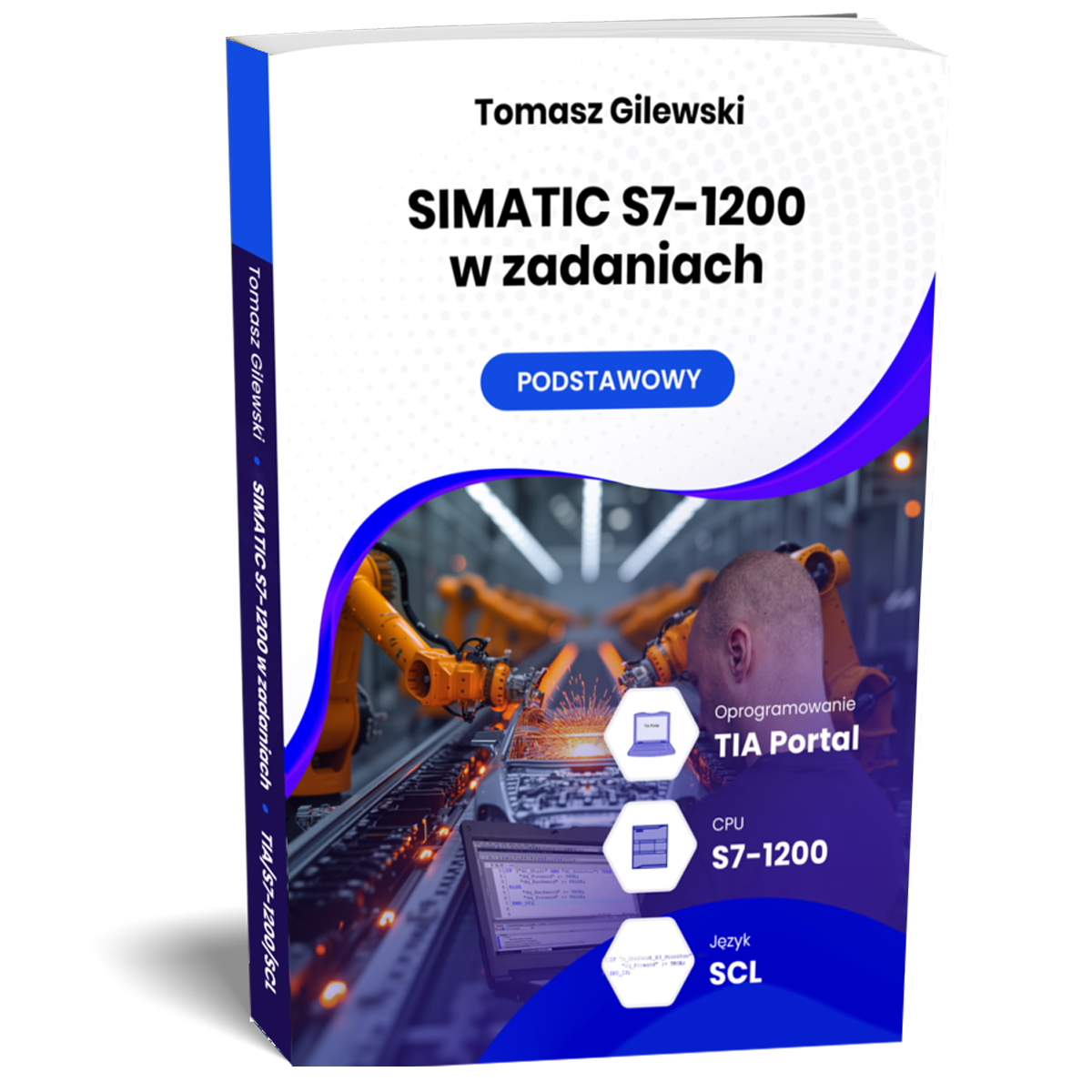PLC programming - no secrets
- Level:
The development environment used in the course
- Software:
Core unit family used in the course
- CPU:
A set of rules that are used to develop programme code
- Language:
Frequency converter (inverter) family used in the course
- Drive
399.00 zł – 499.00 zł
What do you get when you enrol on a PLC programming course?
In our training courses, we focus on clear and understandable messages. We want you to derive real benefits from them and find your dream job. That is why we offer you:
PLC programming - without secrets- Siemens PLC programming course. Basic level Step7
Have you already acquired a technical degree and have a diploma in hand, but aren't sure you can handle the practical side? Then you have come to the perfect place! Our PLC programming course is ideal for beginners who want to consolidate their knowledge and shine right from the start of their career.
Find out that industrial automation can be logical, simple and clear. Don't listen to colleagues with more experience who want to tell you that programming and operating PLCs is a task for the chosen few. After our course, you will go to work with pleasure.
What is this course about?
Our video training will prepare you to operate Siemens Simatic S7-300 controllers. These are some of the most popular main units used in machine automation and production line operation. It is difficult to imagine the smooth operation of industries such as heavy industry, transport or logistics without them.
Five programming languages are used to operate PLCs, but two are the most popular - LAD and STL. It is the former, however, that beats the records for popularity and it is this that we will be dealing with first and foremost.
We know that the time for boring theory is over at school. That's why this course will give you practical PLC programming skills from completely basic to intermediate level. Forget paging through thick books and memorising formulae. This course has one task - to disenchant automation in front of you. Ready? Here we go!
Knowledge test:
Is this course for you? Take this test MULTIPLE choice to check it out.
Egzamin Summary
0 of 11 Questions completed
Questions:
Information
You have already completed the egzamin before. Hence you can not start it again.
Egzamin is loading…
You must sign in or sign up to start the egzamin.
You must first complete the following:
Results
Results
0 of 11 Questions answered correctly
Your time:
Time has elapsed
You have reached 0 of 0 point(s), (0)
Earned Point(s): 0 of 0, (0)
0 Essay(s) Pending (Possible Point(s): 0)
Categories
- Not categorized 0%
- 1
- 2
- 3
- 4
- 5
- 6
- 7
- 8
- 9
- 10
- 11
- Current
- Review
- Answered
- Correct
- Incorrect
-
Question 1 of 11
1. Question
From which block does the PLC start executing the program after power-up ?
CorrectIncorrect -
Question 2 of 11
2. Question
What will happen to the contents of the ACCU 2 battery after the charging operation ?
CorrectIncorrect -
Question 3 of 11
3. Question
Which byte numbers are included in the MD200 address ?
CorrectIncorrect -
Question 4 of 11
4. Question
What will be loaded into the CPU memory when uploading the program and hardware configuration ?
CorrectIncorrect -
Question 5 of 11
5. Question
Is the operation for adding INT and REAL variables implemented in the same ADD block?
CorrectIncorrect -
Question 6 of 11
6. Question
Is a memory card required for the SIMATIC S7-300 family controller?
CorrectIncorrect -
Question 7 of 11
7. Question
What states (values) can the bit assume?
CorrectIncorrect -
Question 8 of 11
8. Question
Is "state 0" returned by
CorrectIncorrect -
Question 9 of 11
9. Question
What is the result of a comparison operation?
CorrectIncorrect -
Question 10 of 11
10. Question
What type of memory is defined as ephemeral (loss of data after power failure) ?
CorrectIncorrect -
Question 11 of 11
11. Question
Which data types consist of 32 bits?
CorrectIncorrect
Key information about the course
You will find that you will be eager to reach for more material yourself. In addition to the basics of PLC programming, we also present the methods and tricks used by the best in the business.
After this course, you will work efficiently on large projects undertaken by large corporations, but also with small applications designed for the individual needs of companies specialising in niche industries.
By beginners and you will also learn how to avoid them. Most courses teach you how the various solutions work, but do not explain why certain strategies are wrong and what mistakes can lead to. We work differently and will explain to you step by step which mistakes you should not make and why.
During this course we will work with the application Collect Box.
The virtual factory will show you the most common problems faced by automation engineers. With the ability to visualise your programming activities, you will see the effect they have in practice. Learn and experiment in a safe environment.
Many years of practical experience means that we only pass on good programming practices to our students. With us, you won't learn clichéd shortcut design. We emphasise detail and care. You can be sure that your future employer will appreciate this.
During this course we will work with the application Collect Box.
Why choose a Siemens PLC programming course?
You will find many PLC programming courses on the market. Why should you choose our training? We have at least a few good reasons why you should learn PLC basics with PLCSpace.
Sample lesson / What you will do after the course
What does a PLC course for beginners look like?
The PLC course consists of 4 parts divided into individual modules. Each is designed to cover a specific group of topics.
You will find that the theoretical knowledge you have gained during the training will be useful in practice.
Upon completion of all modules, you will receive a certificate of completion.
If you are looking for a great course to explain the basics of machine automation, choose the PLCspace learning platform. With us you will take care of your development!
-
A general inventory of the issues discussed in this course:
- introduction to PLC
- Development of the PLC of the SIMATIC S7-300 family
- electrical connection
- extension with digital input and digital output modules
- expansion with analogue modules
- voltage reading from the analogue module
- configuration of the programmer and PC
- Step7 software v5.5
- first project (PLC configuration, symbolic addressing,
writing code in the LAD language) - programme code preview
- available data types for Siemens PLC
- markers
- data blocks
- modification of bit values and variables
- creation of FC functions in the LAD language
- binary operations
- setting and deleting bits
- interrupts (OB blocks for error handling)
- PLC hardware diagnostics
- PLC software diagnostics - use of dedicated
functions - pulse generator
- edge detection of digital signals
- timing functions (implementation of delays)
- counter functions - comparison functions
- mathematical functions
- basics of visualisation and HMI
-
Module 1
- Installation of Step7 v5.5 SP3 (Win7)
- PLCSIM installation (Win7)
- Installation of Step7 v5.6 SP1 (Win 10)
- PLCSIM installation (Win10)
-
Module 2
- Licence activation
-
Module 3
- About the course author
- Basic CPU parameters
- Design and function of the modules - Application of signal modules
- Project creation in Step7 v5.5
- Setting up the communication interface
- Exercise
- Adding stations to the project
- Project structure in Simatic Manager
- Creation of a hardware configuration
- CPU parameterisation
- Addressing inputs/outputs in the controller
- Exercise
- Save HW configuration settings and send to the module,
- Reading from the PLC with PG of the current hardware configuration (so-called Upload)
- Exercise
- Launching the editor for creating blocks
- Types of programme blocks
- Programming languages
- Addressing the controller's memory
- Operandy
- Absolute addressing
- Data types
- Symbolic addressing
- Exercise
- Launching the LAD editor
- Binary operations in the LAD language
- Simple testing - Monitor mode
- Variable table
- Comparison operations
- Exercise
- MOVE function
- Arithmetic operations
- Exercise
- Counters,
- Timed intros (Timers)
- OB blocks in response to errors
- Exercise
-
Module 4
- Factory IO installation
- Factory IO licence activation
- Practical example - Conveyor application
-
Module 1
- Facility description
- Hardware configuration
- Symbolic names
- Download project
- Connection to Factory IO
- IO test
- Layers in the design
- DB data blocks
- Input signals
- Output signals
- Modes of operation
- Error handling
- Traffic lights
- Manual mode
- Automatic mode
-
Module 1
- Facility description
- Hardware configuration
- Symbolic names
- Download project
- Connection to Factory IO
- Layers in the design
- DB data blocks
- Input signals
- Output signals
- Modes of operation
- Error handling
- Traffic lights
- Manual mode
- Automatic mode
Software and hardware used
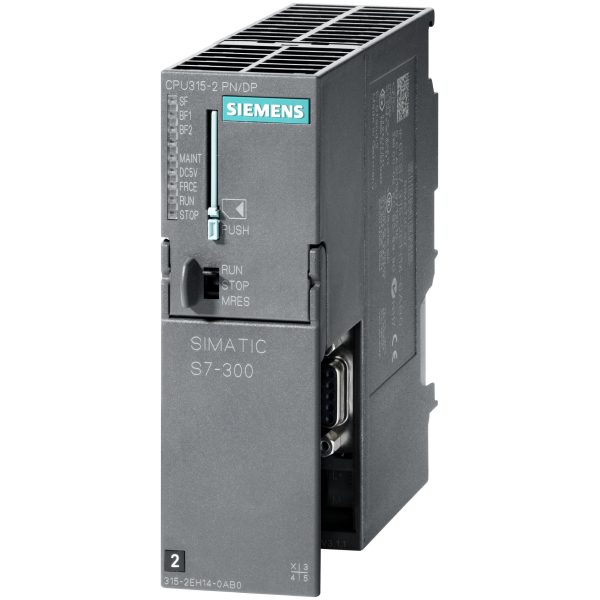
CPU S7-300
It comes in classic and et200s housing. it is currently the most popular and frequently used in industry. It can be seen in almost every industrial plant. It has the best performance-to-price ratio. It is very efficient, making it easy to carry out complex automation tasks,
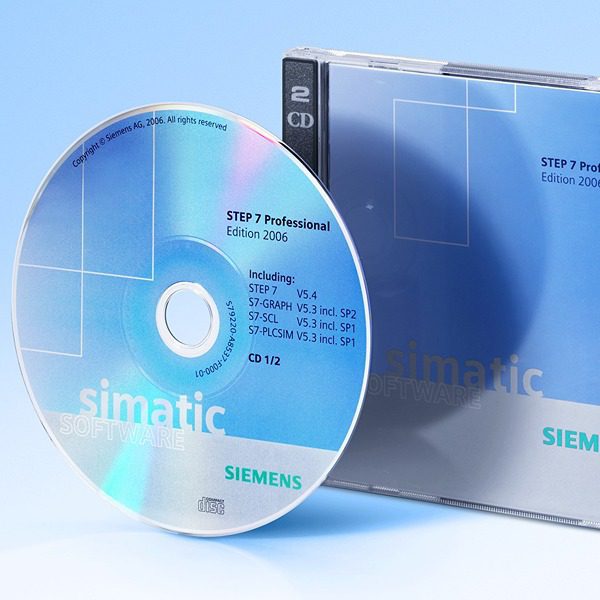
Step7 Software
The most popular version of the classic development environment called Step7 v5.5 with Service pack 3 (can be downloaded free of charge from the Siemens website)
What will you be able to do after completing the course?
Graduating from a technical school is quite a challenge and you've probably wondered more than once what to actually do with that diploma. We have great news for you. You will use Siemens PLC programming for a wide range of jobs. You will find that after our course you will be able to change jobs like the proverbial gloves - you will choose what you specialise in.
Do you know what the main problem with the current education system is? To a huge extent, classes focus on dry theory, and students have little chance to gain the practical skills so desired by employers. Our training aims to give someone with no programming experience a ready-made solution to help them do better in the job market


Guarantee
and certificate
If, after 14 days of purchase, you find that it is not for you, I will refund 100% of the course price. Upon completion of the course, you will receive a certificate in two languages - Polish and English.

Frequently asked questions
-
Will I receive a confirmation after my purchase?
Yes, you receive an email. Sometimes emails end up in SPAM or other folders. Please check your mailbox carefully.
-
Is there a difference between the media on which the course can be ordered?
No. The material is the same regardless of the type of storage medium. At the time of purchase, you decide which type of data carrier you choose, i.e. online, DVD or USB.
-
Which PLC programming language should I choose when starting out?
If you are an electrician then LAD. If there has been any exposure to text-based languages (C, C++, C#, Java, etc) then SCL. If there has been no exposure to any programming at all then the basic course is LAD and SCL (the solution to each task is shown in two languages).
-
Is this course for me if I have never used a PLC?
Yes. The basic courses are just set up so that people with no exposure to Siemens PLCs can learn such skills. The student is guided step by step (as can also be seen in the course table of contents).
-
What tools are used for consultation?
Consultations take place via Skype or TeamViever.
-
How do I make an appointment for a consultation?
Please send an email to biuro@plcspace.pl with your questions (problems) and suggestions for a convenient date for your consultation (via Skype or Teamviever).
-
How long are the consultations valid?
This is 60 calendar days from the date of purchase.
-
Can I deliver the course on different computers?
Yes. The course material (videos) can be viewed on any computer.
-
What does the online version of the course look like?
You receive the course by email, where there are private links to the videos.
-
What if a problem arises during the course?
Please email me with a description of the problem at: biuro@plcspace.pl.
-
What is the access time for the course?
No time limits for any medium (i.e. online, DVD or USB version).
-
Do I need to have any experience with programming?
No. The basic course gives step-by-step all the information needed from 'scratch'.
-
Will I need to purchase a licence for the Factory IO software?
No. There is information in the course on how to obtain licences to complete the material.
-
Will I need to purchase a licence for the PLC development environment?
No. There is information in the course on how to obtain licences to complete the material.
-
Is it possible to return the course?
Yes.
-
Will I need a PLC to deliver the course?
No. A real controller is not necessary. The course is designed in such a way that it can also be completed on a virtual controller. It all depends on what the trainee has at their disposal.
-
How do I buy a course?
Just click Add to basket and complete the form and make payment.
-
When does the course start?
-> Online version - immediately after payment
-> Physical version - when you receive the package from the carrier.
Buy as a set and save
Select at least 2 courses from the list and the first free book item (three selections in total) and an automatic discount of 25% will be calculated in your basket.
If you want to find out more about a particular course, click on its name and the page will take you to its offerings.
Companies that have benefited from our courses




































Feedback from students
 Stanislaw
Stanislaw
What sets this course apart is the opportunity to acquire practical, concrete knowledge. Everything is clearly explained. Definitely recommended!
 Marcel
Marcel
After going through the course, I know what the components of the programming environment are and what to do step by step. Now I feel confident and know what I am doing
 Leon
Leon
Course delivered in a very accessible way. Contains a lot of interesting and useful information.
 Michael
Michael
I can honestly recommend the course. It is solid and factual knowledge. I will definitely be buying more.
 Victor
Victor
Thanks to the course, I have decided to go further in this direction. The goal is to look for a more challenging and better job
 Peter
Peter
The course prepared by Mr Tomasz is distinguished by its high level of content and meticulously prepared lessons. They are planned in a clear and sensible manner, making it easier to assimilate knowledge and return to the material if necessary. An additional advantage is the possibility of a free consultation.
 Nikodem
Nikodem
Definitely recommended! The facts themselves, no unnecessary dwelling on issues.
 Ignatius
Ignatius
This is my first course, certainly not my last. I am impressed with the substantive quality of the knowledge.
 Tymon
Tymon
Everything clearly explained, you can really learn a lot. Lots of practical information and examples to help you remember everything. In my opinion, it is worth using this form of learning because you can learn anytime and anywhere. It is practical and convenient.
You may also be interested in:
- Level:
The development environment used in the course
- Software:
Core unit family used in the course
- CPU:
A set of rules that are used to develop programme code
- Language:
Frequency converter (inverter) family used in the course
- Drive
39.00 zł
- Level:
The development environment used in the course
- Software:
Core unit family used in the course
- CPU:
A set of rules that are used to develop programme code
- Language:
Frequency converter (inverter) family used in the course
- Drive
39.00 zł
- Level:
The development environment used in the course
- Software:
Core unit family used in the course
- CPU:
A set of rules that are used to develop programme code
- Language:
Frequency converter (inverter) family used in the course
- Drive
1.824.00 zł
- Level:
The development environment used in the course
- Software:
Core unit family used in the course
- CPU:
A set of rules that are used to develop programme code
- Language:
Frequency converter (inverter) family used in the course
- Drive
39.00 zł
